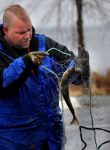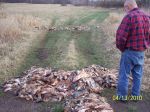There's a "serious problem" with Minnesota's most popular fish on one of the state's most popular lakes.
Amid that backdrop, the Department of Natural Resources announced new walleye regulations for Lake Mille Lacs on Tuesday, March 19, scrunching the size of fish that anglers can keep and crunching the bag limit to two per day.
Starting with the May 11 walleye opener, anglers will be allowed to keep two fish between 18 and 20 inches, or one fish in that slot and one longer than 28 inches. Last season, anglers could keep four fish daily shorter than 17 inches or three under 17 inches and one over 28 inches.
The new regulations, as well as looser rules for keeping northern pike and smallmouth bass, are designed to boost the lake's famed walleye population, especially younger walleye, whose numbers have been declining.
"We have a serious problem on Mille Lacs," said Dirk Peterson, the DNR's fisheries chief. Fall gillnet surveys estimated the lake's walleye population at its lowest in the 40 years the current survey method has been used.
The lake's naturally reproducing walleye population is still robust enough to sustain itself, Peterson and DNR biologists said, but the lake needs more "small fish-friendly" regulations to allow the future of the fishery to come along.
That won't happen in one season.
"We hope to see some turning of the corner in the next two to three years," Peterson said. Biologists have eschewed the notion that the lake is biologically "out of balance," as many resort owners and guides have asserted. Instead, officials say, the fishery is out of kilter with the expectations of many fishermen.
Mille Lacs of late has become known for producing only large walleye, which last summer frustrated many anglers hoping to bring home a live-well full of smaller fish for the frying pan. (Under last season's rules, those larger fish often were too big to keep.)
The lake also has become home to large smallmouth bass and hefty northern pike, both populations likely the result, in part, of protective length and bag limits. Too many large predator fish of any kind is a concern because each large fish needs more food to survive -- food that won't be available to smaller fish. And those large fish can eat the smaller fish.
In an effort to moderate the number of large pike and smallmouth bass, the DNR is loosening those rules.
Anglers will be allowed to keep up to six smallmouth bass under 17 inches daily, or five under 17 inches and one over 21 inches. Last season, only one fish longer than 21 inches could be kept. In other words, what had been a trophy-only management regime is now set up with an eye toward a dinner table perhaps bereft of walleye.
The daily limit
for northern pike will remain at three fish, but the protected slot -- the range in which all fish must be released -- will be 33 inches to 40 inches, a shrinkage from 27 inches to 40 inches. One pike longer than 40 inches can be kept, same as last season.Creating a narrow walleye harvest slot isn't unprecedented on the lake, but the "safe harvest level" -- the total tonnage of walleyes killed that the massive lake can handle -- has been set at 250,000 for the 2013-14 season. That's half last season's level and the lowest level since 1997, when treaty management between the state and American Indian tribes began.
Members of Chippewa Bands whose descendants signed on to an 1837 treaty retain court-upheld rights to fish Mille Lacs outside the jurisdiction of the state of Minnesota. They include the Fond du Lac and Mille Lacs bands in Minnesota and six Wisconsin bands.
The most controversial of their practices is to net walleyes in the spring, as the fish are spawning. During the tribal-regulated season of two to three weeks, young male walleyes, which linger around spawning areas, are heavily fished.
Tribal netting alone doesn't explain the falling numbers of small fish in the lake, but there is a movement within Indian groups to reduce the number of small fish taken, said Charlie Rasmussen, spokesman for the Great Lakes Indian Fish and Wildlife Commission.
"What the tribes are looking to do is encourage more spearing than in the past," Rasmussen said. "A vast majority of the harvest has been by nets, and tribal biologists have looked to see spearing making up a larger percentage."
Spearing is more selective than netting, and as a way to remove more larger fish, tribal officials are removing the maximum size limit on walleyes that can be speared, he said.
Currently, there is no plan to change netting practices. "That's a consideration for tribal managers to consider in the future," Rasmussen said.
Peterson said the DNR has "had conversations" with tribal officials over netting, but he said the agency did not directly ask that the practice cease during closed-door discussions earlier this winter to set the safe harvest levels.
Levels for this year are 178,750 pounds of walleyes for non-tribal members and 71,250 for tribal members. Rasmussen noted the bands could have claimed more.
"The long-term health of the lake is front and center," he said. "The bands and the state both share that concern and are taking measures to reduce mortality of younger fish."
The fundamental problem of the walleye fishery appears to be that too few young walleye are surviving to adulthood. Biologists from the DNR and GLIFWC say they don't know all the causes, although they suspect several might be at work. Changes in the forage and effects of invasive species are among the possibilities.
Both the state and tribes are planning a number of studies.
Dave Orrick can be reached at 651-228-5512. Follow him at twitter.com/OutdoorsNow.

















